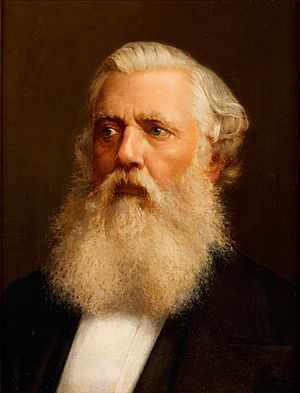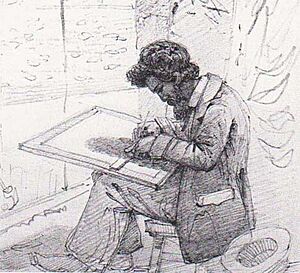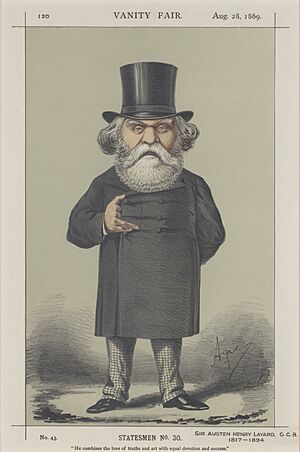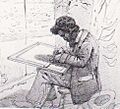Austen Henry Layard facts for kids
Quick facts for kids
Sir Austen Henry Layard
|
|
|---|---|
 |
|
| Under-Secretary of State for Foreign Affairs | |
| In office 12 February 1852 – 21 February 1852 |
|
| Monarch | Queen Victoria |
| Prime Minister | Lord John Russell |
| Preceded by | The Lord Stanley of Alderley |
| Succeeded by | Lord Stanley |
| In office 15 August 1861 – 26 June 1866 |
|
| Monarch | Queen Victoria |
| Prime Minister | The Viscount Palmerston The Earl Russell |
| Preceded by | The Lord Wodehouse |
| Succeeded by | Edward Egerton |
| First Commissioner of Works | |
| In office 9 December 1868 – 26 October 1869 |
|
| Monarch | Queen Victoria |
| Prime Minister | William Ewart Gladstone |
| Preceded by | Lord John Manners |
| Succeeded by | Acton Smee Ayrton |
| Ambassador to the Ottoman Empire | |
| In office 1877–1880 |
|
| Monarch | Queen Victoria |
| Preceded by | Sir Henry Elliot |
| Succeeded by | The Earl of Dufferin |
| Personal details | |
| Born | 5 March 1817 Paris, France |
| Died | 5 July 1894 (aged 77) London, England |
| Nationality | British |
| Political party | Liberal |
| Spouse | Mary Enid Evelyn Guest |
Sir Austen Henry Layard (born March 5, 1817 – died July 5, 1894) was an amazing British adventurer. He was an archaeologist, explorer, art expert, and politician. He is most famous for digging up ancient cities like Nimrud and Nineveh. These cities were part of the powerful Assyrian Empire.
Layard found many incredible things during his digs. He uncovered large stone carvings from Assyrian palaces. In 1851, he even discovered the famous library of Ashurbanipal. This library held thousands of ancient clay tablets. Most of his discoveries are now kept at the British Museum in London. He also wrote popular books about his travels and discoveries.
Later in life, Layard became a politician. He was a Member of Parliament from 1852 to 1869. He also worked as a diplomat, representing Britain in other countries. He served as an ambassador in places like Madrid and Constantinople (now Istanbul). He spent his later years in Venice, Italy, where he collected many beautiful paintings.
Contents
Layard's Family Life
Austen Henry Layard was born in Paris, France. His family had French roots, but they were mostly English. His father worked for the government in Sri Lanka. Austen's uncle, Benjamin Austen, was a lawyer in London. He was also a close friend of a famous British politician, Benjamin Disraeli. Austen also had a brother named Edgar, who studied birds.
On March 9, 1869, Austen Layard married his cousin, Mary Enid Evelyn Guest. They got married in London. Mary was known as Enid. Their marriage was a happy one, but they never had any children.
Austen Layard's Story
Early Adventures and Discoveries
Austen Layard spent much of his childhood in Italy. There, he went to school and learned to love art and travel. He also studied in England, France, and Switzerland. After working for his uncle for about six years, he decided to travel. In 1839, he planned to go to Sri Lanka by traveling across Asia.
He explored many places, especially in Persia (modern-day Iran). He traveled with the Bakhtiari people, a nomadic group. After a while, he changed his mind about going to Sri Lanka. In 1842, he returned to Constantinople (now Istanbul), the capital of the Ottoman Empire. There, he met Sir Stratford Canning, the British Ambassador. Canning gave Layard some special jobs helping with diplomacy in Europe.
In 1845, Layard began his most famous work. With help from Canning, he started exploring ancient ruins in Assyria. He had been very curious about these ruins during his earlier travels. He was especially interested in the large mound of Kuyunjik near Mosul and the ruins of Nimrud on the Tigris River. Another archaeologist, Paul-Émile Botta, had already started digging at Kuyunjik.
Digging Up Ancient Cities
Layard stayed near Mosul, digging at Kuyunjik and Nimrud. He also studied the people living there. In 1847, he returned to England. In 1848, he published a popular book called Nineveh and Its Remains. This book described his amazing discoveries.
To show off the ancient objects, he also published a large book of drawings. It was called The Monuments of Nineveh. From Drawings Made on the Spot. After a few months in England, Layard received an honorary degree from the University of Oxford. He also won a medal from the Royal Geographical Society.
In August 1849, Layard went on a second expedition. He returned to Constantinople as part of the British embassy. This time, he explored the ruins of Babylon and other ancient mounds in southern Mesopotamia. During this trip, he found the famous Library of Ashurbanipal. This library contained thousands of clay tablets with ancient writings.
Layard wrote another book about this trip, called Discoveries in the Ruins of Nineveh and Babylon. He also published another book of drawings, A Second Series of the Monuments of Nineveh. During these expeditions, Layard sent many incredible artifacts to England. These objects now make up most of the Assyrian collection at the British Museum.
Layard believed that the Christian communities living in the Near East were descendants of the ancient Assyrians. His books were not only important for archaeology but also great travel stories.
Layard was also involved with the Arundel Society, which promoted art. In 1866, he became a trustee of the British Museum. That same year, he started a company called "Compagnia Venezia Murano." This company sold beautiful Venetian glass in London. Today, this company is still famous for its Venetian art glass.
A Career in Politics
After his archaeological work, Layard entered politics. In 1852, he was elected as a Liberal MP for Aylesbury. For a short time, he was an Under-Secretary for Foreign Affairs. However, he often criticized the government, especially about how the army was run.
He was in the Crimea during the Crimean War. He was also part of a group that looked into how the war was managed. In 1855, he turned down a job offer from Lord Palmerston. He was also elected as the lord rector of Aberdeen University. On June 15, he proposed a resolution in the House of Commons. He said that jobs in government were given based on connections, not on skill. This idea was defeated.
After losing his seat in Aylesbury in 1857, he went to India. He wanted to find out why the Indian Mutiny had happened. He tried to get elected in York in 1859 but lost. However, in 1860, he was elected for Southwark. From 1861 to 1866, he was Under-Secretary for Foreign Affairs. He served under Prime Ministers Lord Palmerston and Lord John Russell. When the Liberals came back to power in 1868, Layard became the First Commissioner of Works. He also joined the Privy Council.
Working as a Diplomat
In 1869, Layard left his government job. He was sent as an ambassador to Madrid, Spain. In 1877, Lord Beaconsfield appointed him as the Ambassador to Constantinople. He stayed there until 1880, when William Ewart Gladstone became Prime Minister again. At that point, Layard retired from public life. In 1878, he was honored with the title of Knight Grand Cross of the Order of the Bath. This was during the Berlin Congress, an important meeting of European powers.
Retirement in Venice
Layard decided to retire in Venice, Italy. He bought a beautiful 16th-century palace on the Grand Canal. It was called Ca Cappello. In Venice, he spent much of his time collecting paintings from the Venetian school of art. He also wrote about Italian art.
He was a follower of his friend Giovanni Morelli, an art historian. Layard updated a book called Handbook of Painting, Italian Schools in 1887. He also wrote an introduction for a translation of Morelli's book Italian Painters. In 1887, he published a book about his first journey to the East. It was called Early Adventures in Persia, Susiana and Babylonia. This book was very popular.
Austen Henry Layard passed away on July 5, 1894, in London. His body was cremated, and his ashes were buried in a cemetery in Dorset, England.
Images for kids
See also
 In Spanish: Austen Henry Layard para niños
In Spanish: Austen Henry Layard para niños








